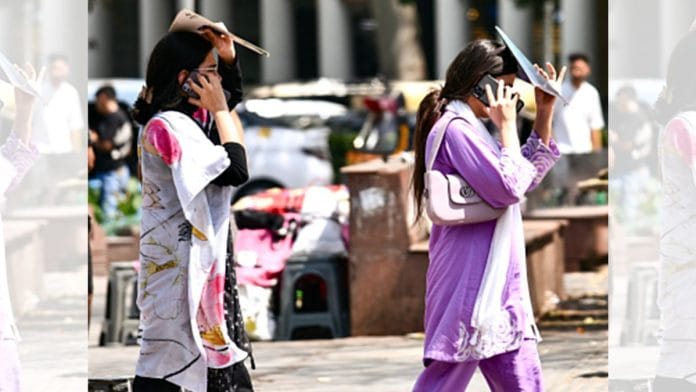New Delhi: The thunderstorm Wednesday brought some respite from the heat for Delhi residents, but Raghubir Yadav knew it was only temporary. Over the past weekend, the construction contractor based in Delhi’s Dwarka, was out all day purchasing material for his new project. Having returned all drenched in sweat and dizzy from the scorching sun, he felt certain that the temperature that day was way past the 40-degree Celsius mark.
However, as he picked up the newspaper the next morning to read about the summer finally arriving in the Capital, he was shocked to learn that the daytime temperature recorded the previous day at the Safdarjung observatory—Delhi’s representative station—was just about 40 degrees Celsius.
He also found that at Palam—about 25 km from the city centre, where the Safdarjung observatory is located—the temperature was nearly 43 degrees Celsius.
Delhi and its neighbouring satellite towns might appear like tiny dots on the Indian map, but the temperature recordings see a variation every few kilometres. Over the last few years, the Capital’s more urbanised and populated pockets have been consistently recording warmer days by at least 2-3 degrees Celsius, compared to the greener and spacious residential areas.
A senior India Meteorological Department (IMD) official said that some areas in Delhi are emerging as “urban heat islands”. The lack of ample greenery, heavy concretisation and dense population make these centres warmer than their surrounding areas.
However, he added that while weather monitoring agencies often dismiss these pockets as anomalies, the majority of the city’s population experiences such high temperatures, and not those that flash on the IMD database.
“This is called the micro-climate of an area. Other factors, like excess use of air conditioning, vehicles plying on the roads, etc, also play a role in increasing the heat intensity of an area,” the official explained.
Also Read: With hotter nights and more humidity, India’s urban heat crisis is tightening its chokehold
Heat disparity in cities
Between north and south, and east and west, Delhi residents experience varying temperatures.
IMD data shows that on 3 April, for instance, the maximum temperature recorded at the Safdarjung observatory was 39 degrees Celsius. On the same day, at the Ridge station, the mercury rose to 40.6 degrees Celsius—six degrees above the season’s normal. In Mayur Vihar, the temperature that day was 35.8 degrees Celsius, and at Pusa and Rajghat, it hovered around 36 degrees Celsius.
The department’s historic data confirms similar trends. Between 2009 and 2024, maximum temperatures for the month of May have hovered between 43 and 45 degrees Celsius. The all-time highest temperature recorded at Safdarjung for May since 1901 was 47.2 degrees Celsius, on 29 May, 1944. In Palam, however, the record for the month has been 48.4 degrees Celsius. Safdarjung and Palam are Delhi’s oldest and most consistently recorded stations.
While the entire city is experiencing an overall trend of intense temperatures, which are rising each season, some pockets have it worse.
A new study by Delhi-based think tank, Council on Energy, Environment and Water (CEEW), highlighted that extreme heat now poses a risk to 57 percent of Indian districts, home to around 76 percent of the population.
The study found that 417 out of 734 Indian districts fell in the high and very high-risk categories. These vulnerable pockets are spread across Delhi, Maharashtra, Goa, Kerala, Gujarat, Rajasthan, Tamil Nadu, Andhra Pradesh, Madhya Pradesh and Uttar Pradesh.
The report particularly highlighted the trend of not just higher daytime temperatures, but also more uncomfortable nights and increased humidity. Data shows that Delhi has experienced a 6-9 percent rise in relative humidity. On average, the city has also recorded six additional ‘very warm nights’ every summer.
Shrinking green cover, expanding urban spaces
According to experts, Delhi is stuck in a vicious cycle of heat, which is made worse by the extensive use of air conditioning. Shrinking green cover and increasing number of concretised structures are also making summer worse.
Mahesh Palawat, vice president (meteorology and climate change) at Skymet Weather—a private weather forecasting agency—said that urban heat islands tend to trap heat, delaying the natural process of cooling. “High use of concrete, heat-trapping material in city planning, extensive use of air conditioning, makes the temperatures worse.”
He said that this season, Delhi and the adjoining states have felt intermittent periods of respite because of continuous western disturbances. However, the dreaded heat is now back, and here to stay till at least the first week of June.
“Delhi usually sees its first spell of heatwave by this time. That has not happened yet because of the regular rains. But we are in for an extreme spell now, and as usual, some areas will experience it worse than the others,” Palawat warned.
(Edited by Mannat Chugh)
Also Read: Everyone in north and central India must adapt to extreme heatwaves. Spring has vanished






